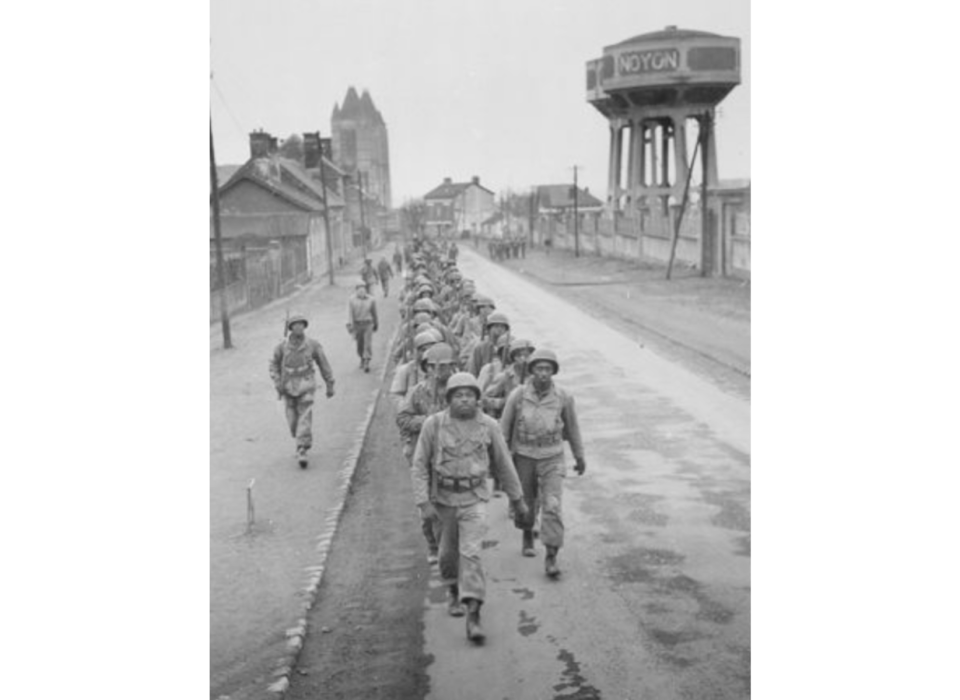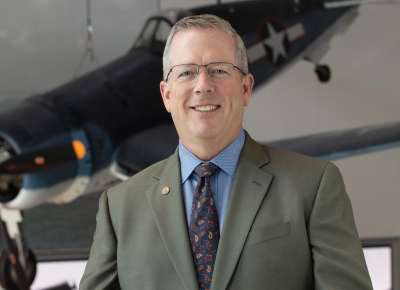Top image: Black Volunteer infantry soldiers prepare for a day's training in preparation for shipment to veteran units at front lines in Germany. Courtesy National Archives and Research Administration, National Archives Identifier: 531357, Local Identifier: 111-SC-337901.
Many historians have written about the famous “Buffalo Soldiers” of the all-Black 92nd Infantry Division, who fought with distinction during World War II. On the other hand, far less has been written about the Black infantry volunteers who served in the European Theater during the final weeks of World War II. The US Army followed a strict segregation policy in its employment of Black troops during World War II, and rarely assigned them to the combat arms, but in January 1945, severe shortages of infantry replacements led General Dwight D. Eisenhower to revisit this policy. This resulted in a brief but important experiment in the employment of African American troops as infantry soldiers with significance that extended well beyond V-E Day.
The War Department knew before the invasion of Normandy on June 6, 1944, that personnel shortages would limit the availability of infantry replacements during the ensuing campaign in Europe. In February 1944, General George C. Marshall had discussed the problem with Lieutenant General Lesley McNair, commander of Army Ground Forces. McNair showed Marshall some disturbing statistics from the campaign in Italy. While the infantry made up only 11 percent of all US Army personnel fighting in Italy, infantry soldiers had suffered 60 percent of the total casualties incurred in the campaign so far.
Marshall shared this casualty information with President Franklin D. Roosevelt the next day, explaining that the invasion of France would only worsen the issue. This led to War Department initiatives to improve public perception of service in the infantry and to raise the morale of the rifleman, such as the creation of the Expert Infantry Badge. These programs, however, did little to increase numbers of infantry replacements.
As the flow of replacements from the States continued to decline, in July 1944 the European Theater’s Ground Force Replacement Command began converting soldiers from other specialties into infantry replacements. While this practice did increase the available number of infantry replacements, it was not enough to keep up with the extreme casualty rate, which, by early December, was projected to result in a shortage of 23,000 riflemen in the ETO. On average, and infantry regiment in three months of combat sustained 100 percent casualties (killed, wounded, or missing). The Battles of Metz, Aachen, and the Huertgen Forest proved especially costly.
On December 8, Lieutenant General John C. H. Lee, commander of the Communications Zone, planned to provide most of the 23,000 infantry replacements needed by making available 20,000 of his white soldiers for retraining as infantry. To reach the 23,000-mark, Lee made a novel proposal. Noting that African American units were the only untapped source of troops in the ETO, Lee recommended seeking Black volunteers for the honor of frontline service as junior enlisted infantry soldiers.
General Eisenhower concurred with Lee’s recommendation, but when he learned that Lee intended to assign the volunteers to white units as individual replacements without regard to color or race, he objected. Eisenhower was reminded by his Chief of Staff, General Walter B. Smith, that this would constitute a major departure from longstanding War Department policy, Eisenhower directed modifications to Lee’s plan. Soldiers would have the opportunity to volunteer without regard to color or race, but they would be “suitably incorporated” into their gaining units. With the Battle of the Bulge raging, the call to volunteer issued on December 26, 1944, was therefore vague about how the volunteers would be employed. Still, 4,562 Black troops had volunteered by February 1945, with the first 2,800 reporting for retraining in January and early February.
Many of the African American volunteers were non-commissioned officers who accepted reduction in rank to take part in the program. They were older than average infantry soldiers and had a higher proportion of high school graduates and Army General Classification Test (AGCT) Class I-III ratings (the top three ratings out of five) than average Black troops in the ETO. Still, the volunteers were more like the average African American soldier than they were different. As the official historian noted, only their motivation and the way they would be employed truly set them apart from their peers. Organized as the 47th Retraining Battalion of the 5th Retraining Regiment, they reported to the 16th Reinforcement Depot at Compiègne, which had been retraining support troops as riflemen for the past three months. The volunteers immediately stood out, with fewer disciplinary issues and absences than the white soldiers retraining there.
While the volunteers learned their new trade, the leadership debated how they would be employed. Lieutenant General Ben Lear, who had recently arrived in theater to serve as General Eisenhower’s deputy commander, assumed responsibility for the reinforcement system. He soon learned that Eisenhower intended for the volunteers to be trained as infantry rifle platoons, which would be distributed among white units and provided platoon leaders, platoon sergeants, and, if necessary, squad leaders. They would not be employed in armor or artillery units unless they expressed a preference to do so.
Since this was a unique program, the system would produce no additional African American infantry replacements after this initial group was assigned to units. Therefore, Reinforcement Command organized the first 2,253 trainees in 37 platoons of 60 riflemen, 50% larger than typical 40-man platoons. With this extra manpower, the platoons would provide their own replacements internally. Some of the platoons engaged in hard fighting from the Rhineland to Bavaria during the final weeks of the war in Europe, but with resistance collapsing in various places along the front, others were mostly involved in mopping up and occupation duty.
The retrained platoons soon found themselves in either the 12th or the 6th Army Group. In the 12th Army Group, they were employed as Eisenhower intended, as added, or “fifth” infantry platoons in infantry divisions rifle companies. However, the 6th Army Group assigned the platoons to armored divisions, where they were organized into provisional companies that served as armored infantry in support of tanks or with tank support.
The platoons assigned to infantry divisions quickly gained the respect of their fellow soldiers, as shown in the reports required by the army and theater headquarters personnel who tracked their performance. Infantry commanders described them as outstanding riflemen and wished they could obtain more African American platoons. Their bravery under fire soon won them the respect of the white soldiers of adjacent platoons, some of whom remarked that they liked to fight alongside the Black platoons because they laid such a large volume of fire on enemy positions.
The Black volunteers who were organized into armored infantry companies had a mixed record. Since their retraining involved only individual and some squad- and platoon-level training, they were unprepared to perform company-level administrative roles, untrained in the use of support weapons, and unfamiliar with armored combat. While the platoons assigned to 6th Army Group made a good impression on their peers, neither their level of motivation and commitment to battle nor their combat efficiency rose to the same level as that of their peers assigned as intended to infantry divisions. Still, the reflection of one of their battalion commanders, quoted in the official history, reflects the general assessment of the Black volunteers’ performance in the ETO:
I know I did not receive a superior representation of the colored race as the average AGCT was Class IV. I do know, however, that in courage, coolness, dependability and pride, they are on a par with any white troops I have ever had occasion to work with. In addition, they were, during combat, possessed with a fierce desire to meet with and kill the enemy, the equal of which I have never witnessed in white troops.
Illustrating this point, two African American volunteers in the 9th Infantry Division earned major decorations for gallantry in less than six weeks of combat. Private First Class Jack Thomas, in the fifth platoon of E Company, 60th Infantry Regiment, led his squad in an attack against a strongly defended German roadblock, supported by a tank. He lobbed two grenades, wounding several Germans, before picking up the bazooka dropped by wounded soldier and immobilizing the tank. He then picked up a wounded comrade and carried him to safety amid intense enemy small arms fire. For this action, he earned the Distinguished Service Cross. Another fifth platoon member, Private First Class Edgar E. Zeno of G Company, 39th Infantry Regiment, was awarded the Silver Star after assaulting an enemy position in the face of heavy machine gun fire, killing seven German soldiers and wounding three more.
When the war in Europe ended, the African American volunteers experienced a blow to their morale. Redeployment regulations included a point system to determine which soldiers were qualified to return home with their units. Since the Black platoons did not enter combat until just weeks before V-E Day, they had fewer points than their white counterparts, and many found themselves transferred to other units rather than returning home with the division with which they had just served and fought. Meanwhile, the effort to evaluate their combat performance continued beyond war’s end, as policymakers debated how the experiment should influence employment of Black troops going forward.
General Marshall, after considering the views of his field commanders and staff officers, believed that the army should continue to work towards integration of African American troops into white units. He did not believe, however, that the experience of these Black volunteers was a useful source of data, and he did not approve the release of that data to the public. Marshall noted that these were volunteers of higher quality than average African American soldiers, and the experiment involved segregated employment, even if at a low level.
Still, the success of these Black volunteers was undeniable, as shown by the results of post-war surveys of their white commanders, non-commissioned officers, and peers. Over 80 percent of officers and NCOs surveyed responded that the African American volunteers performed very well in combat, with similar percentages reporting that comradeship between white and Black troops was better than expected. The experience of the fifth platoons exploded many of the racial stereotypes that had persisted in US Army policies.
Although the performance of the Black volunteer infantry platoons did not directly result in significant policy changes, it informed the ongoing debate about employment of Black troops. The War Department formed a board of officers in October 1945, headed by Lieutenant General Alvan C. Gillem, Jr., to consider the implications of the employment of African Americans as combat troops during the war. The board’s report guided the War Department’s policy deliberations going forward.
Finally, on July 26, 1948, President Truman signed Executive Order 9981, directing the military to provide equal treatment and opportunity for all servicemen. The order read, in part, “It is hereby declared to be the policy of the President that there shall be equality of treatment and opportunity for all persons in the armed services without regard to race, color, religion or national origin.”
Further Reading:
- Ulysses Lee, The Employment of Negro Troops, United States in World War II. Washington, DC: Government Printing Office, 1963.
Mark T. Calhoun, PhD
Mark T. Calhoun, PhD, is a former Senior Historian at the Jenny Craig Institute for the Study of War and Democracy.
Cite this article:
MLA Citation:
APA Citation:
Chicago Style Citation:






![Max Fuchs, New York City cantor, sings as Rabbi Sydney [sic] Lefkowitz, Richmond, VA, conducts the first Jewish services from Germany.](/sites/default/files/styles/max_650x650/public/2025-10/image1.jpg)


